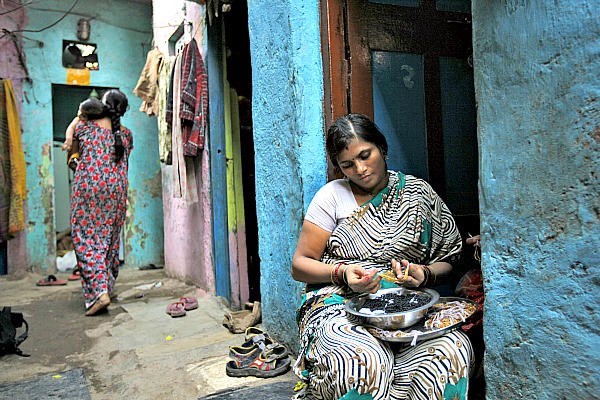Microcredit programs in developing countries now include other features such as connections to markets and savings accounts, as well as business development, health, and education services.

|
| Shobha Vakade, who took a loan of rupees 18,000 ($400) from a microfinance company to start her own business, strings beads into necklaces outside her house in a slum in Mumbai, India. Microloan groups are expanding to include other services to clients, including savings accounts and health and education services. Danish Siddiqui/Reuters/File |
One of the best ways to encourage economic growth in poor areas is to provide affordable small loans to farmers and small-business owners. Called microcredit or microloans, these programs can inject capital into communities that lack the collateral required by conventional banks.
Today, Nourishing the Planet introduces five innovative microcredit programs that are encouraging economic growth in poor communities.
1.
Farmer-to-farmer programs: Microcredit programs tend to be most sustainable when they promote cooperation between residents of a community. Encouraging farmer-to-farmer support can be an effective technique because it allows participants to be less reliant on outside financing and guidance.
Farmer-to-farmer programs in action: When Africa's Sustainable Development Council (ASUDEC) connects farmers with microcredit loans, the recipients have several expectations placed upon them. ASUDEC requires farmers to not only pay back the loans, but also to offer equally affordable loans to their neighbors. This policy generates a ripple effect, helping communities increase their incomes and fund their own progress, rather than relying on ASUDEC. As the trust and cooperation between farmers builds, it "helps the poor transition from subsistence to entrepreneurship," says ASUDEC'S Director, Dr. Salibo Some.
2.
Integrated economic support: While gaining access to affordable lines of credit is an important step for poor farmers, it isn't always enough to provide real financial stability. Some microcredit programs go beyond small loans and offer many services, such as connections to markets, supply regulation, and savings accounts.
Integrated economic support in action: BRAC, formerly Bangladesh Rural Advancement Committee, started its microfinance program in 1974 in Bangladesh, and now provides asset- and referral-free microloans to impoverished people in 16 countries. The largest development organization in the world, BRAC's aim is to "use microfinance groups as a social platform to deliver scaled-up services in health, education, business development, and livelihood support." They provide specialized loans ($50 to $700) and training for young women, and larger loans ($700 to 7,000) to existing small enterprises. All of these loans come with access to a range of services, including savings, technical assistance, and marketing. Over 99 percent of BRAC's 7 million borrowers pay back their loans on time.
3.
Training centers: Without the necessary knowledge and training, many farmers who receive microloans would struggle to increase their production and pay back loans. Most microcredit programs, therefore, link their loans with training and education on up-to-date techniques and practices.
Training centers in action: Ecova Mali was started in 2007 in order to provide grass-roots development in Mali. The two main thrusts of its program are providing farmers with training in sustainable agriculture and offering microfinancing (loans and grants) to help farmers start environmentally and socially responsible enterprises. It has a permanent training facility in Mali, where local experts teach fellow Malians new techniques, such as using natural fertilizers, aquaculture, and biogas, and explain why they are preferable to traditional methods. Once they receive the education, the farmers may be offered loans or grants to get started on their own eco-friendly, profitable farms.
4.
Health information programs: The history of microcredit programs is not spotless. Financiers have occasionally preyed upon the poor, profiting substantially from microloans. And sometimes loans have proven to be ineffective at delivering immediate relief and aid. One tactic employed by some programs is to link loans directly with health information and care.
Health information programs in action: The Microcredit Summit Campaign was originally launched in 1997 in Washington, DC, as an international effort to bring access to credit to millions of the world's poorest people, especially women. One important facet of its mission is to work with a network of trainers to reach "over half-a-million microfinance clients in 18 countries with life-saving health education lessons." This is crucial to combat insufficient knowledge of nutrition, sanitation, HIV/AIDS, and many other health-related issues. The campaign is specifically trying to establish self-sustaining education systems through microloans, which are independent of donor support.
5.
Individual investors: Sometimes NGOs and governments fail to provide services where and when they are needed. Dedicated individuals, however, can contribute immeasurably to their communities by utilizing and encouraging microfinancing and partnerships that build trust and cooperation.
Individual investors in action: Dinnah Kapiza, an agrodealer in Malawi, lost her husband in 1999, and she responded by taking a training course in business that came with a microloan. She used that money to start a new agro-dealership, Tisaiwale Trading, which sells agricultural supplies, such as seeds and tools, to roughly 3,000 nearby farmers in Malawi. Her business is flourishing, providing affordable supplies and technical training on how to best use them, and she is working to connect women's groups to their own microcredit.
Page created on 8/19/2012 12:00:00 AM
Last edited 8/19/2012 12:00:00 AM

